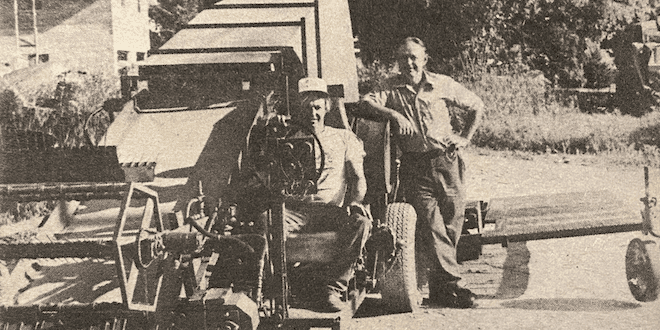

Sep 7, 2021Mechanical strawberry harvest got Michigan boost
Growers have been in pursuit of innovative methods to harvest strawberries mechanically for quite some time. Recent breakthroughs have seen automated strawberry harvests take place in select fields in California and Florida, as the robots become more commercial and less experimental in an era where labor availability continues to be a challenge.


In the May 1983 issue of the Great Lakes Fruit Growers News (the predecessor of Fruit Growers News), a front-page story focused on the efforts of Jim and Joe Grant’s new mechanical strawberry harvester that they developed. It wasn’t a Cadillac yet, according to Jim Grant, but at least it was at the Model A stage. That means it was doing a reliable, efficient, serviceable job of mechanically picking the fruit.
Following is a synopsis of the story of the two Grant brothers.
The basic design and engineering have been proven, Jim Grant said, and all that needs to be added is refinements to upgrade some of the features without altering the fundamental concepts underlying the machine.
The Grants are partners in Grant Farms near Lake Leelanau in Michigan’s Leelanau Peninsula, in the heart of tart cherry country. Tart and sweet cherries are their main crops, but they also raise 10 acres of strawberries. Like many other strawberry growers in the state, they got jittery after their 1975 labor experience.
“There was a deficit of pickers that year,” Jim Grant said. “So farmers got excited.”
There was a flurry of activity aimed at development of mechanical harvesting equipment, including funding of research by Manistee and Benzie County growers to enable Michigan State University (MSU) agricultural engineers to develop concepts and designs.
The Grants liked the basics of what they saw and continued working to achieve the goals they had set out to reach, with considerable additional help from the MSU engineers. Last year they got what they wanted.
“We had a very good harvest year,” Grant said.
At a patch raised by their brother Bill, of Bill and Diane Grant Farms of nearby Suttons Bay, the recovery was 12 tons per acre, while brother-in-law Jerome Kolarik got 12.5 tons out of a patch – all of that harvested strictly mechanically.
To accomplish that, the growers design their fields to fit the mechanical-harvest concept.
“We raise solid-set patches,” Jim Grant said. “We have no walkways, and the entire patch is completely flat.”
There are three advantages to such a system, he said. “First, we can raise more berries per acre that way, so losses from unrecovered berries aren’t so serious,” he said.
“Second, by keeping the soil profile uniformly flat, we can keep the cutter lower to the ground. And third, because of so many plants, the berries can lean against each other and don’t fall so low.”
The Grants have also found that the fruit variety is important to their system. “There really isn’t a strawberry bred specifically for machine harvest, so we use Midway,” Grant said. “It works well. It’s firm and a good processing berry. It also concentrates the ripening, so we have few overripe berries. And green berries have not been a serious problem. In addition, Midway holds berries on stems that the harvester can handle well.”
The harvest equipment is based on a system advocated by the MSU engineers, Grant said.
“There are two schools of thought on how to design mechanical harvesters,” he said. “One is to try to duplicate what a human being does, such as in plucking a berry directly off a stem.”
The other school, adopted by MSU engineers Clarence Hansen, Dick Ledebuhr and Gary Van Ee, is to forget about trying to simulate human movements and to analyze a problem from a machine standpoint.
In the case of the Grants’ strawberry harvesting, that translates into a system whereby all the plant material is cut initially – berries, leaves, leaf stems and berry-cluster stems. This material is then conveyed into a machine where separation of the “wheat” from the “chaff” takes place.
First of all, an air stream passes through the material and blows out the leaves, with just the berries left behind, attached by their cluster stems.
Then those clusters are moved on an open-grid conveyor through another airstream that forces the clusters upward.
“The berries are heavier, so they resist being raised, but their attached stems are lifted up,” Grant said. “These ‘stood-up’ clusters then pass by a mower blade that is adjusted to cut about one inch above the berries.
“So presto! We end up with berries that are no longer attached to any other berries, and each berry has only about a one-inch stem.” That condition leaves the berries in an ideal shape for the in-plant processing machinery that MSU’s Hansen has developed, Grant said.
The Grants’ harvesting system did not spring into being overnight, he said. By 1977, the general interest in mechanization began lagging as a surplus of strawberry pickers re-emerged. The Grants took a longer-run view, however, and decided mechanization would be a kind of insurance.
“If we could be guaranteed pickers every year, permanently, then there wouldn’t be any machines,” Grant said. “So we decided to go ahead and try to build a harvester.”
Their first machine was assembled in 1977, and the cutter head and pickup fingers were tested. A couple of problems ensued – the fingers couldn’t get under the berries well enough, and processors rejected berries with the stems still attached.
The latter problem was resolved the next year after processors were persuaded to install machinery designed by Hansen that allows decapping of berries with stems still attached. Meanwhile, the Grants’ harvester was largely rebuilt that year with Hansen’s and Ledebuhr’s help.
The strawberry patches harvested were still row-and-walkaway types, and the recovery was only about five tons per acre.
In 1979, the harvest was smaller than that. “We never did get more than 2.5 to 3.5 tons off the patches. We were still using rows,” Grant said. But that year an outside observer, the brother-in-law of a neighbor, made a suggestion for a hinged design to lift the fingers, so another step toward improved efficiency was added, he said.
The next year, 1980, saw a “breakthrough,” as the MSU engineers came up with a “double-sickle drive mechanism, a double-sickle hedger,” Grant said. A 12-ton harvest was recovered of a rolled, well-tended two-acre patch belonging to Bill Grant.
There was another breakthrough in 1981 – “MSU’s new blower design,” Grant said. “Besides that, the harvester straight-through design improved the ease of harvesting and removal of the stem harvester. We’re happy with it. It was a good harvest year.”
The machine is not really extremely complex nor is it difficult to operate, Grant said. “Our machine is made so any farmer can run it, though it still takes a pretty good operator. That’s why we say it’s still a Model A. With last year’s model, though, the operator was not as important (in getting the correct functioning of the equipment) as before, but we want to keep making the equipment easier to run. We hope to get to the point where the operator is not important at all.
“We want solid-set plants because then the berries stay hung up in the foliage and they’re easier for the conveyor to get under,” he said. “We want to get the maximum number of berries picked up. Since solid-set means more plants per acre, we get greatly increased production that way, and then we also get greater recovery of the berries.
“That’s why we’re so happy with our mechanized system.”
— Gary Pullano, editor; Photo at top: Brothers Joe, seated, and Jim Grant of Lake Leelanau, Michigan, are shown by the mechanical strawberry harvester that they updated to pick some 14 acres of berries on their farm in northwestern Michigan’s Leelanau County. They processed their own strawberries with equipment they purchased from Canners Machinery Ltd. of Simcoe, Ontario, at the Underwood & Sons processing plant located just north of Traverse City on Old Mission Peninsula.














